For superior time-lapse photography results, invest in high-resolution objectives with numerical apertures exceeding 1.4 and anti-reflective coatings. Choose specialized lenses with long working distances and low phototoxicity features for extended sessions. Fluorescence-compatible objectives with apochromatic corrections excel in multi-channel imaging. Prioritize autofocus-compatible lenses with drift compensation to maintain consistent focus throughout sequences. Quality objectives with aberration correction will greatly enhance your final footage’s visual impact. Discover how these specialized features transform ordinary sequences into extraordinary visual narratives.
Selecting High-Resolution Objectives for Cellular Detail Capture
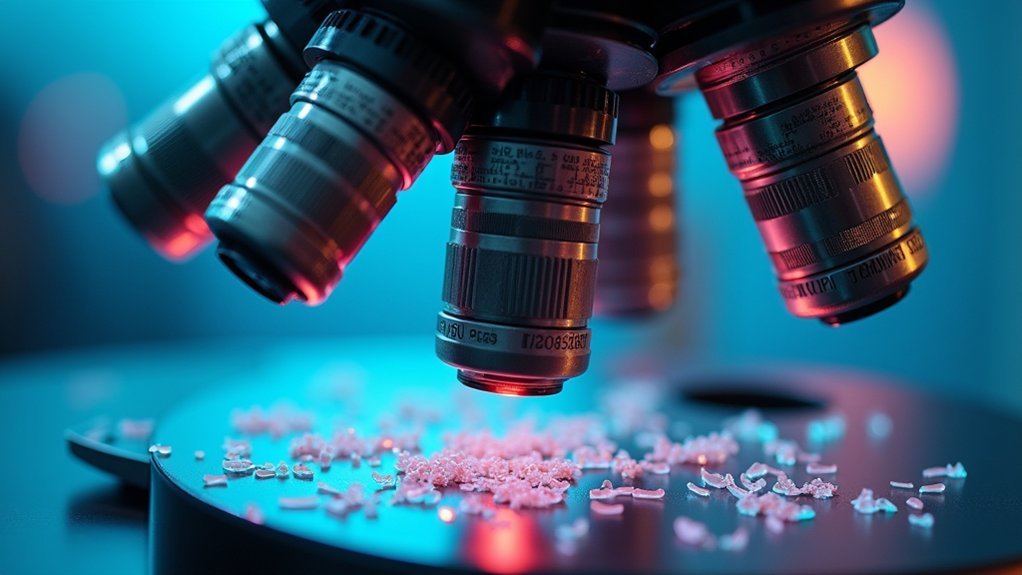
The cornerstone of effective cellular time-lapse photography lies in selecting appropriate high-resolution objectives. When capturing dynamic biological processes, you’ll need objectives with magnifications between 10x and 100x to reveal fine cellular details with clarity.
Selecting the right high-resolution objectives is crucial for revealing cellular dynamics with remarkable clarity and precision.
For high-quality time-lapse results, choose objectives with numerical apertures exceeding 1.4, as these greatly enhance light-gathering capabilities and improve contrast. Consider investing in high-resolution optical objectives with anti-reflective coatings that increase light transmission while reducing unwanted reflections.
For ideal imaging at higher magnifications, oil immersion objectives are essential, as they minimize light refraction and dramatically improve resolution.
When tracking specific cellular components, select objectives designed for particular wavelengths, such as those optimized for GFP fluorescence, to enhance visibility of targeted structures during your time-lapse sequences.
Long Working Distance Lenses for Extended Time-Lapse Sessions
When setting up extended time-lapse sequences, long working distance lenses become invaluable tools that allow you to maintain critical separation between your equipment and biological specimens. You’ll capture natural behaviors without disturbing your subject, whether you’re documenting wildlife movement or plant growth patterns.
| Lens Feature | Benefit | Best For |
|---|---|---|
| Extended focal length | Reduced subject disturbance | Wildlife time-lapse |
| High-resolution optics | Sharp detail at distance | Plant growth studies |
| Specialized coatings | Improved contrast in varying light | Day-to-night sequences |
| Wide aperture capability | Better low-light performance | Dawn/dusk shifts |
| Ideal depth of field | Creative background control | Narrative time-lapse stories |
These lenses provide the perfect balance of proximity and non-interference, letting you create compelling time-lapse photography while preserving the authenticity of your scene’s natural progression.
Phase Contrast Objectives for Enhanced Cell Visualization
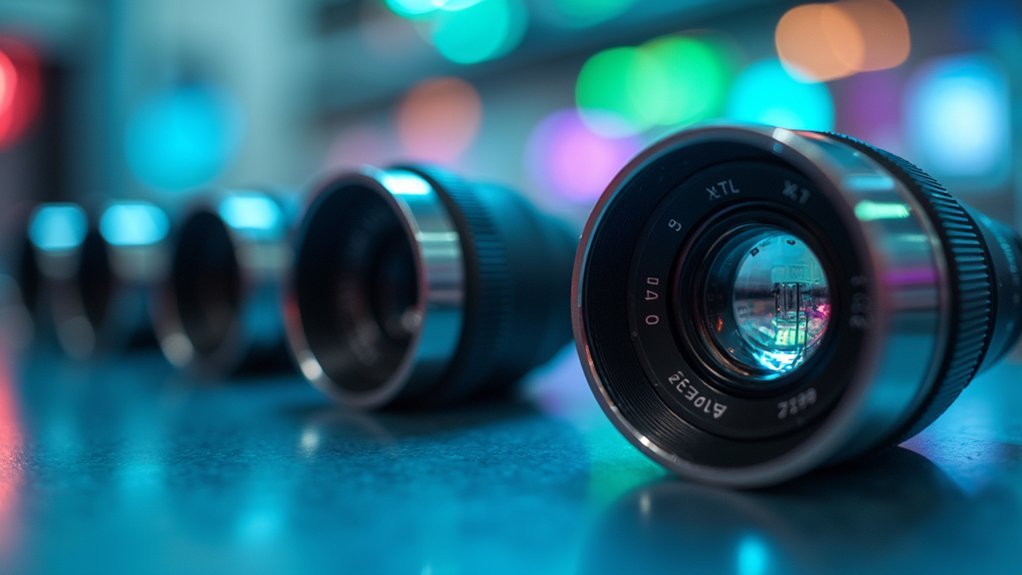
Phase contrast objectives transform your time-lapse imaging by revealing transparent cellular structures without damaging stains, using specialized annular rings to convert phase shifts into visible contrast variations.
You’ll capture intricate cellular morphology with exceptional clarity as these objectives, available in 10x-100x magnifications with numerical apertures up to 1.4, reveal fine details that would otherwise remain invisible.
Proper alignment of these optical systems guarantees artifact-free visualization of dynamic cellular processes, making them invaluable tools for monitoring living specimens throughout extended time-lapse sequences.
Phase Contrast Advantages
Invisible to standard microscopy, transparent biological specimens spring to life through phase contrast objectives in time-lapse photography.
These specialized objectives convert subtle phase shifts into visible amplitude changes, revealing cellular structures without destructive staining procedures.
You’ll appreciate how phase contrast dramatically improves visualization of living samples, allowing you to capture dynamic processes like cell division and migration in their natural state.
This technique’s greatest strength lies in preserving cell viability during extended live-cell imaging sessions by eliminating the need for potentially toxic fluorescent markers.
The engineered annular rings in phase contrast objectives optimize light manipulation, delivering superior contrast and resolution in your time-lapse sequences.
You’ll record biological phenomena with remarkable clarity while minimizing both phototoxicity and photobleaching—crucial advantages when documenting cellular behaviors over hours or days.
Contrast Enhancement Mechanisms
Through ingenious optical manipulation, phase contrast objectives transform invisible cellular details into clearly defined structures during time-lapse photography.
These specialized objectives employ annular rings and phase plates that strategically alter light paths, creating contrast where none would naturally exist.
You’ll notice the dramatic difference when studying live specimens, as cellular membranes and organelles become distinctly visible without harmful staining procedures.
With numerical apertures ranging from 0.25 to 1.4, you can select the ideal objective for your specific resolution requirements.
The contrast enhancement mechanisms are particularly valuable during long exposures in time-lapse studies, preventing the phototoxicity associated with fluorescence techniques.
This allows you to capture dynamic cellular processes over extended observation periods without damaging your specimens, resulting in more accurate and thorough data collection.
Cellular Detail Resolution
Cellular intricacies come to life when you employ phase contrast objectives for time-lapse photography.
With numerical apertures ranging from 0.4 to 1.4, these specialized lenses transform invisible phase shifts into visible contrast, revealing delicate structures without staining or disrupting your specimens.
The built-in annular diaphragms create precise light rings that highlight even the most transparent cellular components.
You’ll capture dynamic biological processes in your time-lapse videos with remarkable clarity, allowing observation of cell division, migration, and interactions in their natural state.
Optimize your exposure time carefully when setting up these objectives—proper alignment is essential for maintaining image quality throughout extended recording sessions.
When correctly calibrated, phase contrast objectives deliver unmatched detail resolution, making them invaluable for researchers documenting subtle morphological changes in living cells over time.
Fluorescence-Compatible Objectives for Multi-Channel Imaging
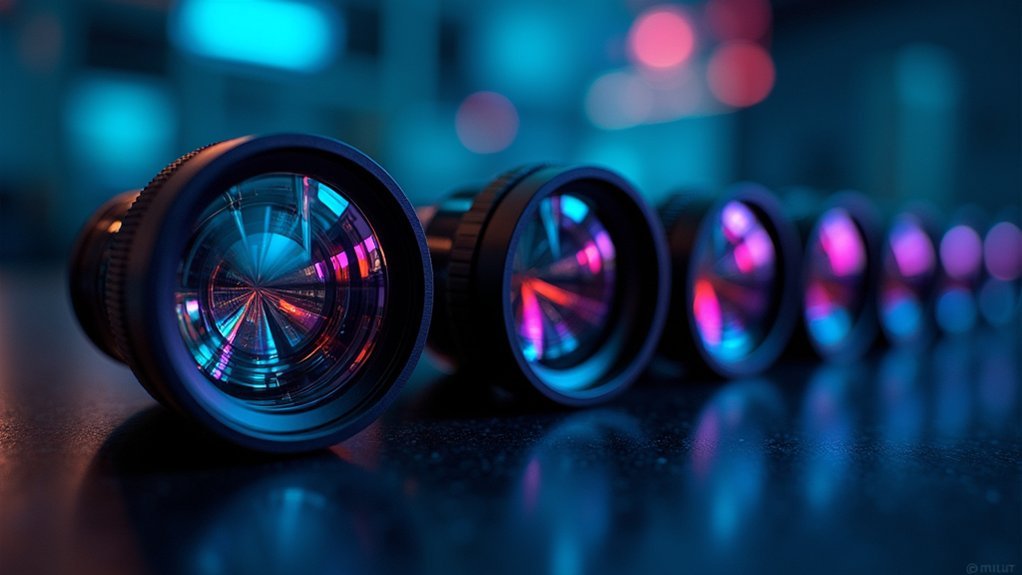
Selecting fluorescence-compatible objectives with high numerical apertures (NA ≥ 1.4) will dramatically improve your multi-channel imaging by maximizing light collection and resolution critical for capturing detailed fluorescence signals.
You’ll need to prioritize apochromatic objectives that offer superior spectral separation capabilities to minimize cross-talk between channels and correct chromatic aberrations across different wavelengths.
Consider objectives with longer working distances to provide flexibility in sample positioning and reduce the risk of damage during extended time-lapse fluorescence experiments.
Spectral Separation Capabilities
When capturing dynamic biological processes across multiple fluorescence channels, your objective’s spectral separation capabilities become critical to success.
Fluorescence-compatible objectives with advanced spectral separation capabilities enable you to clearly distinguish between different fluorophores without signal crossover or interference.
High-quality objectives feature specialized anti-reflective coatings that selectively transmit specific wavelengths while rejecting others, dramatically improving your imaging contrast.
Look for objectives with high numerical apertures (NAs exceeding 1.4) that maximize light collection efficiency while maintaining spectral integrity.
The best fluorescence-compatible objectives also minimize chromatic aberration, ensuring that all wavelengths focus at the same plane.
This correction is essential when you’re tracking labeled structures across multiple channels in time-lapse sequences.
Oil immersion objectives typically offer superior spectral separation and resolution for challenging multi-channel applications.
High NA Considerations
The numerical aperture (NA) of your objective represents a fundamental parameter that directly impacts fluorescence imaging quality in time-lapse applications. When selecting objectives for multi-channel imaging, prioritize those with NA values exceeding 1.3 to maximize resolution and brightness in your fluorescence microscopy studies.
High numerical aperture objectives greatly enhance your ability to detect signals across multiple wavelengths while maintaining excellent contrast differentiation. This proves invaluable when simultaneously tracking different cellular components during dynamic processes.
Consider immersion objectives (oil or water) for their superior light-gathering capabilities, particularly in challenging illumination conditions with live specimens.
Don’t overlook the importance of anti-reflective coatings, which reduce background noise and improve light transmission. These features, combined with chromatic aberration correction across multiple wavelengths, guarantee your time-lapse sequences capture the subtle details of biological processes with exceptional clarity.
Long Working Distance
Successful time-lapse fluorescence imaging often hinges on your choice of long working distance objectives. When selecting these specialized lenses, prioritize those with high numerical apertures (NA) to capture more light during your multi-channel imaging sessions, resulting in clearer, more detailed images.
The best fluorescence-compatible objectives feature anti-reflective coatings that maximize light transmission across multiple wavelengths, essential when you’re tracking different fluorescent markers simultaneously.
You’ll appreciate the extra space between the lens and your specimen, especially when working with thicker samples or when minimizing contact with fluorescent labels is crucial.
For extended observation periods, consider objectives specifically designed for live-cell imaging. These specialized lenses help maintain cell viability while allowing you to document dynamic biological processes thoroughly through multi-channel imaging with your long working distance objectives.
Low Phototoxicity Objectives for Maintaining Cell Viability
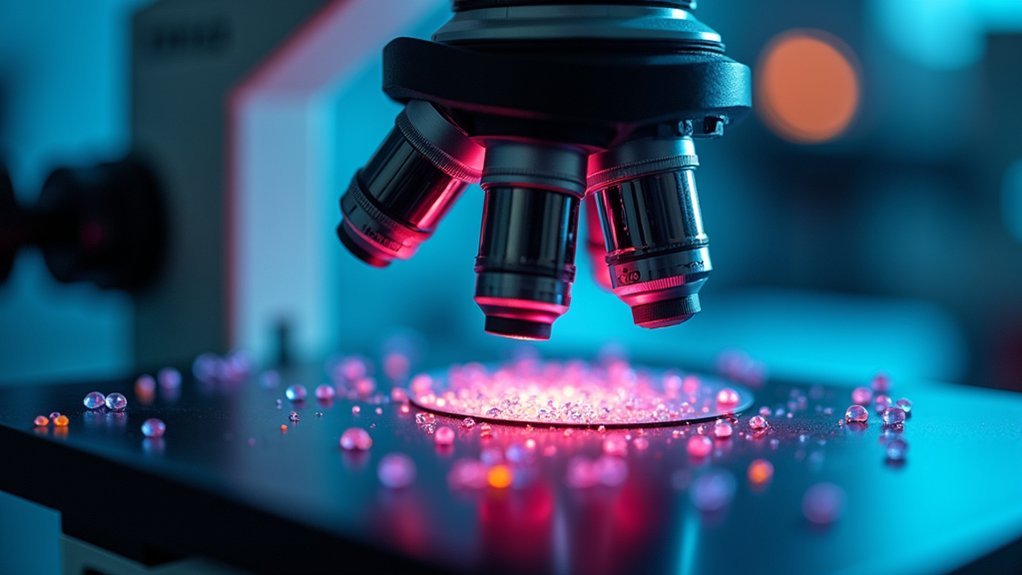
Maintaining viable cells during time-lapse photography presents a significant challenge, as excessive light exposure can damage or kill the very specimens you’re attempting to document. To overcome this obstacle, you’ll need low phototoxicity objectives specifically designed to reduce harmful illumination while preserving image quality.
| Objective Type | Benefits | Applications |
|---|---|---|
| TIRF Objectives | Minimal light penetration, high NA | Membrane dynamics, protein trafficking |
| Multiphoton | Deep tissue imaging, localized excitation | Embryo development, neural activity |
| Specialized Coated | Enhanced transmission, reduced intensity needs | Extended time-lapse, sensitive specimens |
Temperature-Stable Lenses for Environmental Control Chambers
Temperature-stable lenses for environmental chambers must address material expansion challenges, as even small dimensional changes can disrupt your carefully planned time-lapse sequences.
You’ll need to select lenses with matched expansion coefficients and specialized metal alloys that maintain optical alignment across your chamber’s temperature range.
Anti-condensation coatings on these lenses prevent moisture buildup when temperature fluctuations occur, ensuring your images remain crisp throughout extended experimental periods.
Material Expansion Considerations
When conducting time-lapse photography in environmental control chambers, the thermal expansion of lens materials presents a significant challenge that can compromise image quality.
Temperature-stable lenses address this issue through specialized construction that minimizes optical performance variations during extended shooting sessions.
To guarantee ideal results when working with these precision instruments, you’ll want to reflect on:
- Material selection – Opt for lenses constructed from low thermal expansion materials like specialized glass or composites that maintain optical integrity as temperatures fluctuate.
- Environmental stability – Control ambient conditions to prevent focus drift and image distortion.
- Coating quality – Look for advanced optical coatings that enhance light transmission while reducing reflections.
These reflections will help you capture pristine time-lapse sequences of dynamic processes without artifacts from lens thermal instability.
Anti-Condensation Lens Coatings
Moisture presents one of the most persistent challenges for time-lapse photography in environmental control chambers.
When you’re capturing long exposure sequences across temperature fluctuations, condensation on lens surfaces can ruin hours of careful setup.
Anti-condensation coatings address this problem through hydrophobic technology that actively repels water molecules from lens surfaces.
You’ll notice noticeably clearer imaging during extended time-lapse sessions without the interruption of moisture buildup.
These specialized coatings maintain optical clarity while minimizing the need for frequent lens cleaning in humid conditions.
For biological studies, particularly live-cell imaging, these coatings are essential for maintaining specimen visibility.
Oil Immersion vs. Water Immersion Objectives for Live Cell Studies
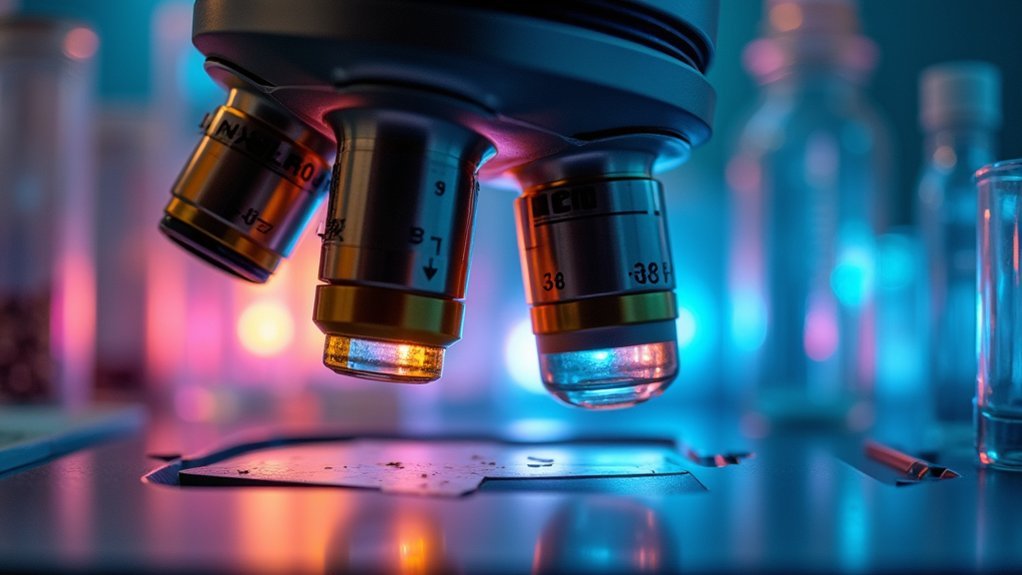
Choosing between oil and water immersion objectives represents a critical decision for researchers conducting time-lapse photography of living cells. Your selection directly impacts both image quality and cell viability during extended observation periods.
Oil immersion objectives deliver superior resolution and contrast due to their higher numerical apertures (NA ~1.52), but come with shorter working distances and maintenance challenges.
Water immersion objectives, while offering slightly lower resolution (NA ~1.33), better support long-term cell viability.
Consider these factors when choosing:
- Experiment duration – water immersion excels for extended time-lapse imaging
- Sample thickness – water objectives accommodate thicker specimens with longer working distances
- Resolution requirements – oil provides maximum resolution for fine subcellular structures
The ideal choice balances your specific imaging conditions with the biological requirements of your living specimens.
Multi-Focal Plane Objectives for 3D Time-Lapse Acquisition
While immersion objectives enhance resolution at a single plane, the complexity of biological systems demands capabilities beyond flat imaging.
Multi-focal plane objectives transform your time-lapse photography by capturing multiple focal depths simultaneously, documenting 3D structures with unprecedented efficiency.
These advanced optical systems utilize light field technology to create datasets that allow you to refocus your images after they’re captured. You’ll save significant time when documenting extensive sequences, as you’re capturing multiple planes in a single pass—ideal for dynamic cellular subjects that don’t wait for conventional imaging.
The technology delivers enhanced depth perception and spatial resolution, giving you clearer insights into three-dimensional relationships.
For your live cell studies, these objectives reveal cellular processes across multiple planes without sacrificing detail or extending acquisition times.
Aberration-Corrected Lenses for Consistent Image Quality
Optical distortions can devastate the quality of your time-lapse sequences, which is why aberration-corrected lenses have become essential tools for serious photographers.
These advanced lenses guarantee your images remain sharp and true to life across the entire frame, even when shooting complex scenes with varying depths and lighting conditions.
When selecting aberration-corrected lenses for your time-lapse projects, consider these advantages:
- Enhanced detail capture – Advanced glass compositions and multi-element designs maximize light transmission for superior resolution.
- Superior color fidelity – Specialized coatings improve contrast and color accuracy during changing light conditions.
- Consistent edge-to-edge sharpness – Minimized chromatic, spherical, and astigmatic aberrations guarantee uniform quality throughout your sequence.
You’ll find these investments particularly valuable for landscape and cityscape time-lapses where consistent image quality can elevate your production value considerably.
Autofocus-Compatible Objectives for Drift Compensation
As subjects shift position and lighting conditions evolve during extended time-lapse sequences, autofocus-compatible objectives become essential tools for maintaining razor-sharp imagery. You’ll find these specialized lenses considerably reduce focus errors while compensating for subtle movements that occur during long exposures.
| Lens Type | Drift Compensation | Best Use Case |
|---|---|---|
| Standard AF | Moderate | General time-lapse |
| Tracking AF | High | Moving subjects |
| Stabilized AF | Premium | Challenging conditions |
When shooting at varying intervals, consistent autofocus performance prevents the flickering that can ruin your sequence. Many modern autofocus-compatible objectives now include face detection and subject tracking features that maintain lock even in difficult lighting. For ideal results, pair these lenses with bodies that support continuous focus adjustment—you’ll appreciate the smoother footage and reduced post-processing time.
Frequently Asked Questions
What Are the Best Settings for Time-Lapse Photography?
For time-lapse photography, you’ll want manual mode with consistent settings, ISO as low as possible, aperture based on your scene, and shutter speed following the 180° rule for smooth motion between frames.
What Is the Best Frame Rate for Timelapse?
You’ll want to shoot at 24-30 fps for your timelapse videos, which creates smooth, cinema-like playback. You can use 60 fps for more fluid motion or 12 fps for a more stylized, time-emphasized effect.
What Is the Best Lens for Time-Lapse?
For time-lapse photography, you’ll find a 24-70mm zoom lens offers ideal versatility. If you’re shooting landscapes, try a wide-angle lens, while telephoto options excel when you’re capturing distant subjects with compression effects.
What Is the Purpose of Time-Lapse?
Time-lapse lets you witness changes that normally occur too slowly to observe. You’ll see flowers bloom, clouds race, or cities transform in seconds, revealing patterns and movements invisible to the naked eye.
In Summary
You’ll get the best time-lapse results by matching your objective to your specific imaging needs. Consider resolution, working distance, and compatibility with your contrast method. Don’t forget to balance phototoxicity against image quality, especially for live specimens. Whether you choose oil, water, or air objectives, make certain they’ll work with your autofocus system to maintain crisp focus throughout your entire acquisition period.





Leave a Reply